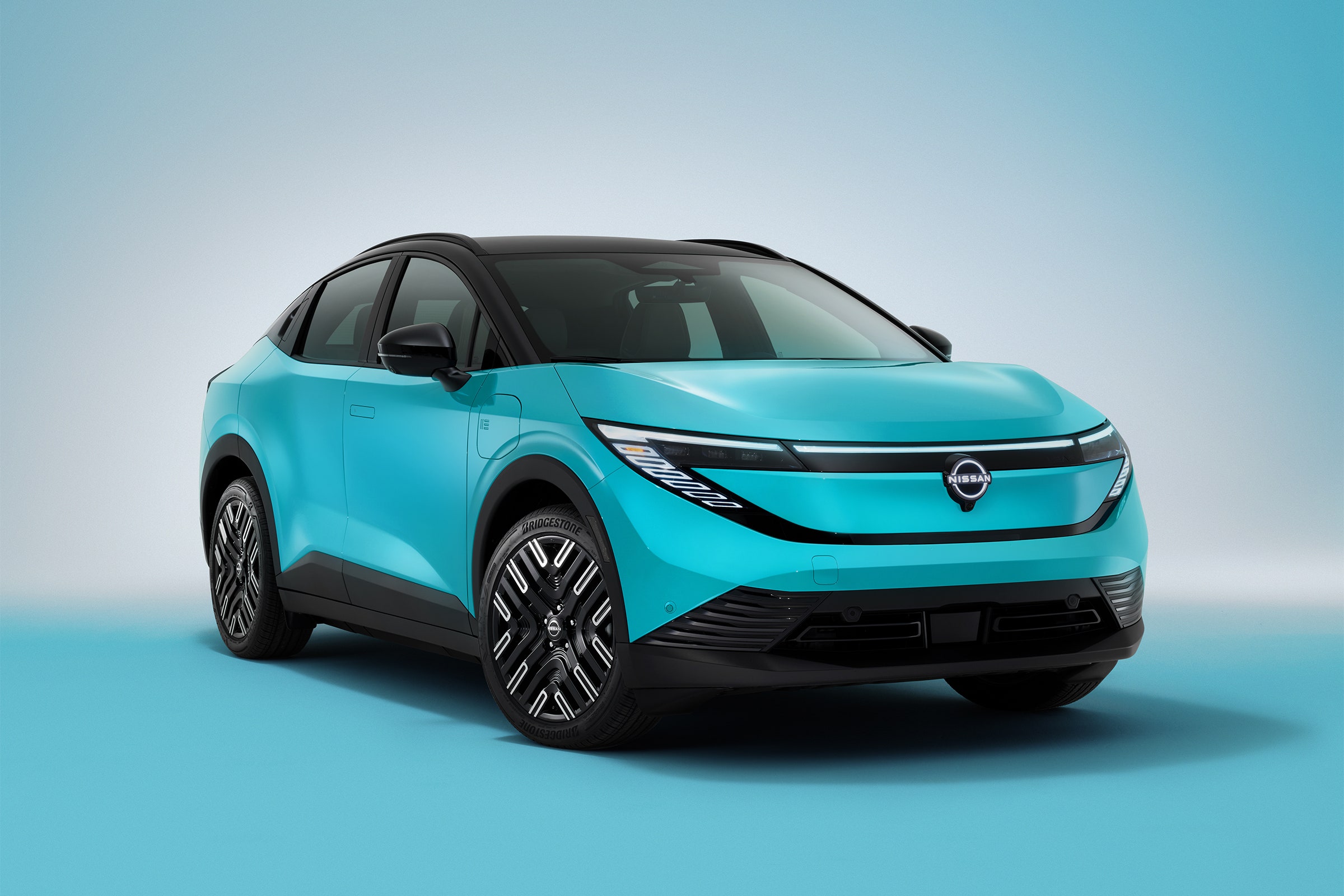Finally, after 15 years, we have a new 2026 Nissan Leaf coming. As befits the ‘truckification’ of global car markets, it’s no longer a compact hatchback. Now, it’s a compact SUV—or, more accurately, a crossover utility vehicle built on passenger-vehicle underpinnings.
The new Leaf will offer a range of up to 303 miles, Nissan says, from a 75-kilowatt-hour battery pack, powering a 160-kilowatt (214-horsepower) motor that produces 261 lb-ft (354 Newton-meters) of torque. That motor drives the front wheels, but despite its tall, utility appearance, all-wheel-drive isn’t on the table.
The 2026 Leaf can charge at up to 150 kW via a NACS (North American Charging Standard) port on the right-front fender, with fast-charging from 10 to 80 percent of battery capacity in 35 minutes under ideal conditions. Drivers will benefit from the standard Plug & Charge protocol that lets them to plug in the car and walk away, with validation and billing handled automatically, at capable charging networks. Notably, the AC charging port with a J-1772 socket is on the left-front fender; dual charge ports remain uncommon outside higher-end models like the Porsche Taycan.
Smaller and Sleeker
Stylistically, the Leaf resembles a smaller Nissan Ariya—the brand’s larger EV crossover. The new Leaf, however, is sleeker—Nissan quotes a drag coefficient of 0.26, down from the prior Leaf’s 0.29 and the Ariya’s 0.297—and uses such drag-reducing features as the company’s first powered, flush-fitting front door handles (the rears are scooped out of the roof pillar behind the rear doors). The very high tail provides a large cargo area, at up to 55.5 cubic feet (1.6 cubic meters) behind the rear seats.
Depending on trim level, the 2026 Leaf comes with 18-inch or 19-inch wheels, though the smaller wheels may produce slightly higher range ratings. A heat pump is standard for cabin heating; Nissan notes the Leaf now captures waste heat from both the power electronics during charging and the drive motor, using it to warm the battery to its optimal operating temperature.
Inside, most models use dual 14.3-inch displays mounted side-by-side on a flat dash tray, à la any number of Hyundai EVs. Google Maps and Google Assistant are built into the dash, and, as with many new EVs, Maps will recommend charging stops on routes that exceed the car’s range. Android Auto and Apple CarPlay phone mirroring remains available, both wirelessly and wired, with available options including an electrically dimming panoramic glass moon roof, and a battery heater, to warm the battery in winter while the car is still plugged in.
Sometime after the 2026 Leaf goes on sale in a variety of trim levels, Nissan also plans to offer a basic Leaf S version with a smaller 52-kWh battery and a 130-kW (174-hp) motor. No range was projected for this configuration, however.
A Long, Checkered History
It’s important to recall that in December 2010, when the first US Leaf was delivered to a paying customer, there were just three cars for sale in the US market with plugs: the Tesla Roadster, a crudely-built $100,000 two-seat roadster; the Chevrolet Volt plug-in hybrid, a concept virtually no salesperson could cogently explain to shoppers; and the Leaf. The Tesla Model S wouldn’t struggle into production for more than 18 months.
Taking perhaps the wrong lesson from the unexpected sales success of the 2004 Toyota Prius hybrid, its designers gave the Leaf a design like no other car on the road. It was all curves, with a beveled nose, swept-back headlights, and almost a bustle on its rounded hatchback rear. “Weird” was the general consensus.
Still, even with only 74 miles of range, it was at least semi-affordable, at around $40,000. And in the following 15 years, Nissan would go on to sell more than 650,000 Leafs globally, with 150,000 of those in the US. But low range and weird looks proved not to be an appealing combination, even if affordable—and the sleek lines, startling acceleration, and 200-plus-mile range of every Tesla Model S soon outgunned the modest little Leaf.
Worse, the Leaf’s Achilles Heel turned out to be the cost-saving decision by powertrain engineers to forego active thermal conditioning for its battery—meaning the pack had no liquid cooling or heating. That worked adequately in most circumstances. But a small number of Leaf drivers in places like Arizona, where pavement temperature just 6.3 inches below the battery can reach 140 degrees Fahrenheit (60 degrees Celsius), found their batteries losing capacity within months, or failing outright.
Overall, according to owner-provided telematics data from battery-health firm Recurrent, 2011 to 2016 Leafs did significantly worse in retaining battery range than the next high-volume EV to hit the market, the Tesla Model S. The average Leaf from that period, says Recurrent, retained only 83 percent of its battery range—versus almost 93 percent for the average Model S. (For what it’s worth, the Leaf still bested the BMW i3, which had an even worse 78 percent.) Recurrent notes any EVs whose batteries were replaced are not called out, nor are any EVs whose batteries died completely and were then scrapped.
For the 2026 Nissan Leaf and the 2023 Ariya before it, Nissan learned its lesson. The new Leaf’s battery pack is liquid cooled; Arizona EV drivers can rest easy.
Losing Its Lead
The first-generation Leaf has had a staggering 15-year model life, albeit with one major redesign in 2018 to make it less odd-looking—which succeeded, as it now largely resembles every other small Nissan. Over that time, battery capacity grew from 24 to 62 kilowatt-hours in various iterations. An EV launched with a 74-mile range was EPA-rated as high as 212 miles for the Leaf Plus model. US production began in 2013, though it’s expected to wind down this year.
Former Nissan CEO Carlos Ghosn was an early champion of EVs. He was also, however, a relentless cost-cutter, and he axed multiple proposed new EV models, intending that the Leaf first show that EVs could be profitable. Every Leaf sold for many years likely lost more money for the company; instant profitability is a tall order for any new technology. Toyota has acknowledged it lost money for almost 10 years on its first two generations of Prius.
Ghosn was arrested and jailed in Japan for financial misconduct in 2018, then fled the country to Lebanon while on house arrest. Nissan has never regained its footing. EVs were not, frankly, its biggest problem. And that’s where we remain today, with Nissan now planning to close assembly plants, slash jobs, and retrench for survival following a failed Honda merger.
Over those 15 years, Nissan utterly squandered its first-mover advantage. Could it have taken lessons from Tesla, and launched a more stylish, longer-range EV to establish a range of electric-car options? It could have … but it didn’t. With close to 100 separate EV models on sale in the US today, the Leaf faces tough competitors from around the globe—if not yet China. The new Leaf will compete with a score of smaller, front-wheel-drive crossovers from Hyundai, Kia, Chevrolet, Volkswagen, and others. We’ll wait for a first drive to see how it stacks up.
Very likely, the 2026 Nissan Leaf will likely be a competent, efficient smaller EV crossover. But it’s hard not to think what might have been if Nissan had stayed the course.




